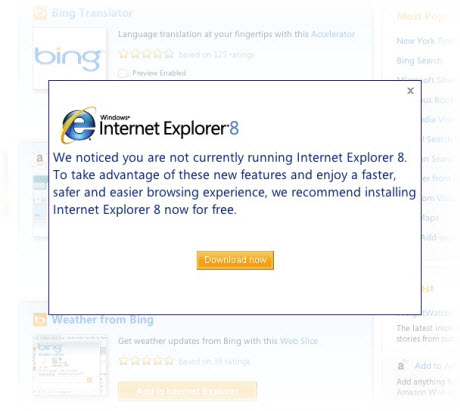Microsoft needs to learn how to speak Apple and Android

Five years ago, Microsoft might have been justified in assuming that every visitor to its web site was running Windows. In 2011, that assumption is just unrealistic. Yes, Windows still commands an overwhelming share of the market for desktop and portable PCs, but these days people get information from other places, like iPads and Android smartphones and MacBook Pros. None of those devices are running Microsoft operating systems.
Microsoft is aware that those other markets exist, of course. They’ve got Office for Mac 2011, and they just released Microsoft OneNote for iOS devices like iPhones and iPads, and you can get Windows Live Mesh for Mac. There are Bing apps for iOS and Android (on all U.S. carriers as of last November. Most Microsoft online services these days work shockingly well in non-Microsoft browsers on non-Microsoft devices. So why isn’t Microsoft talking directly to the people who are using those other operating systems and devices?
I thought about that earlier this morning, when I had an odd interaction with Microsoft.com. As you might recall, I’ve been using a Mac and a PC side by side for the past few months, shifting between environments throughout the day and sometimes as part of the same task.
This morning, someone on Twitter pointed me to a bookmark manager add-on for Internet Explorer. That tweet included a link that took me to the IE add-ons page at Microsoft.com. I clicked the link in TweetDeck, which opened the page in Google Chrome. On a Mac.
Now, Microsoft should know I’m using a Mac and not Windows. It’s right there in the User-agent string that went along with my request:
Mozilla/5.0 (Macintosh; U; Intel Mac OS X 10_6_6; en-US) AppleWebKit/534.13 (KHTML, like Gecko) Chrome/9.0.597.94 Safari/534.13
So here’s a close-up of what they served me in response:

"We recommend installing Internet Explorer 8 for free.” Really? How very thoughtful.
Except I can’t. As you and I and everyone on the planet knows, Microsoft doesn’t make a version of Internet Explorer for OS X, or indeed for any operating system besides Windows. So that offer is a little hollow. But there it is.
And what happens if you click the Download Now button? You get this:
As user experience goes, this is pretty awful. It’s almost a bait-and-switch deal.
Microsoft: “You want Internet Explorer for free?”
Me: “Sure, why not?”
[click]
Microsoft: “Sorry, you can’t have it. Can we sell you Windows 7 instead?”
That first page was perfectly capable of detecting my OS. When it sees I’m running OS X and not Windows, it knows for a dead certainty that I can’t install Internet Explorer. It shouldn’t force me to visit another web page to learn that self-evident truth.
I get an equally unhelpful result if I visit the Microsoft Fix It Solution Center on a Mac. Imagine this scenario: I have a PC and a Mac at home. For some reason, my PC can no longer reach the Internet. I can’t use it to find help online. So I go to the Mac, where my connection is alive and well, and I make my way to the Microsoft support site. Here’s what I find:
Those top two solutions sound like they’re worth trying. But a Run Now button? Really? That can’t possibly work on a Mac.
But there it is, and it doesn’t say anything like “Windows only.” So I click, and Chrome downloads a Windows executable file and saves it in the Downloads folder on my Mac. At that point, I am on my own.
They could offer some instructions on how to copy that file to a USB flash drive and then run it on the PC. But they don’t, and I’m left to figure things out for myself.
An awful lot of devices these days are running non-Microsoft operating systems, including tablets and phones. Smartphones are outselling PCs in many markets. In the scenario above, where I need help figuring out why my Windows PC is unable to connect to the Internet, I might use an Android-powered phone or an iPad to search for help over a 3G connection.
Every visitor who comes to microsoft.com using a Mac or an iPhone or a Droid has slightly different information needs and a set of new and interesting interoperability challenges. Wouldn’t it be smart to anticipate those needs? In the process, instead of trying to sell me a copy of Windows 7, why not point me to services like Bing and Windows Live SkyDrive that will help me connect my Windows PC and my non-Windows device?
Microsoft is missing an opportunity here. Really.